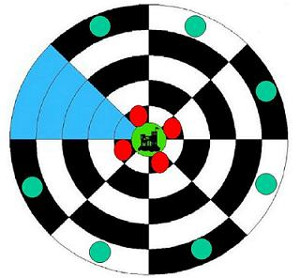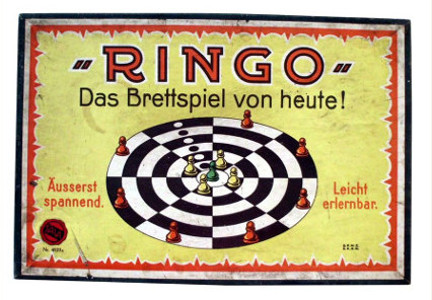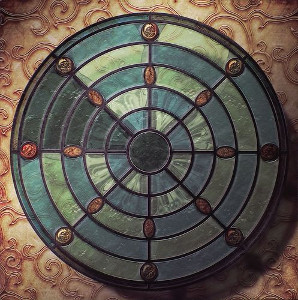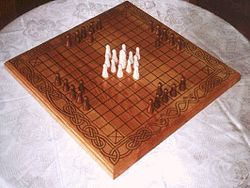Ringo
Written by Howard Fosdick © BestFreeNewGames.com
Overview: Ringo is a really fun two-player board game -- a bit like checkers in the round. What makes it especially interesting is that the two forces are unequal. One player defends the castle with four playing pieces, while the other tries to capture it with seven.
The game dates from the late eighteenth or early nineteenth century in Germany. Little more is known of its origins.
The Board: The first figure below shows how the Ringo playing board appears. (Click here to download a free game board.)
The second figure shows how the Ringo board appears at the start of the game. The Defender has four playing pieces arrayed around the Castle he defends, while the Attacker has seven positioned in the outer ring. In the figure, Defender is Red and Attacker is Green.
Objective: The Attacker wins if he or she can get two pieces into the Castle. The Defender wins if he prevents this. One way to prevent it is to reduce the Attacker to a single playing piece.
How to Play:
As in checkers (draughts), players alternate turns. Each player may move only 1 piece per turn. Only 1 piece can occupy any position, with the exception of the Castle. Up to two Attackers can occupy the Castle (thus winning the game), but no Defender may ever occupy the Castle. The Attacker always takes the first turn to start the game.
Attacking pieces can move one space towards the Castle, or one space sideways to an adjacent space in the same ring. Attacking pieces can not move backwards or outwards (to an outer ring). Defending pieces can move one space forward, backward, or sideways (to any adjacent position).
Pieces are captured as in checkers or draughts. You jump an opponent’s piece to an unoccupied position on the other side of it. As dictated by their movement capabilities, Attackers can jump over a piece in front of them, or to either side. Defenders can jump over a piece in front of them, behind them, or to either side. You can only jump a single opposing piece per turn. You can not jump your own pieces. Captures or jumps are never mandatory.

A Defender can jump an Attacker inside the Castle and capture it. However a Defender may never enter the Castle or land there in a jump move.
Special rules apply to the Neutral Zone -- the area coloured blue in the graphic. Enemy pieces in the Neutral Zone can not be captured, although they can be jumped. You can start or end a jump from the Neutral Zone -- you just can not capture any piece residing within it.
-----------------------------------
Rules Variations:
When playing Ringo, alternate who is Defender and Attacker each game. Playing an even number of games thus evens the odds when playing a match.
Most people find the Attacker has a slight advantage. Use one of these rules variations to even this out:
- Attackers can not enter the castle from the Neutral Zone
- Allow the Defender to pass a turn
- Give Attacker only 6 or 5 playing pieces
- Allow only 1 Attacker piece in the Neutral Zone at any time
-----------------------------------
Tips for Play:
This is a game of unequal forces and asymmetrical setup.The two players have different goals.
The Attacker can ONLY go forward -- there is no retreat for him -- since his pieces can not go "backwards", moving outward from the ring's center. The Attacker should think carefully before each move because he is progressively committing his pieces. The only "withdrawal" for him is to move pieces sideways.
In contrast, the Defender can move his pieces in any of four directions. Though he has fewer markers, this gives him a distinct movement advantage on which he should try to capitalize. He can also jump enemy pieces in any of four directions. Sometimes a good move is to get behind an Attacker piece and jump him by moving towards the center of the ring. This both eliminates the enemy piece and quickly moves the Defender piece back towards a good defensive position. Another advantage is that when the Defender maneuvers behind an Attacking piece, the Defender can jump the Attacker but the Attacker can not jump the Defender.
The Defender also has a movement advantage in that he distributes his moves between four pieces, versus the Attacker's seven. The Defender has a smaller, more fluid army, whereas the Attacker's attention is diverted into managing a larger force. But take care not to lose a piece if you're the Defender! The imbalance of forces means that a one-for-one trade-off represents a loss for the Defender. Especially in the beginning of the game this is a loss from which it is difficult for Defender to recover.
-----------------------------------
Print Your Own Game Board:
Want to print your own game board? Click here to download printable game boards for any game on this website. You don't need to buy anything to play!
-----------------------------------
Sources:
Originally sourced from R.C. Bell, Discovering Old Board Games. For another take on Ringo rules, read this description or this Wikipedia article.
The printable brown and white game board is courtesy of the Bona Ludo Blog.
If you like board games, see our pages on Teeko, Camelot/Cam/Camette, Brandubh, and the Jungle Game.
Ringo Boards



Tafl Games
Games of unequal strength, or in which the two players have different numbers of playing pieces, are sometimes referred to as Tafl games. There are a large number of such games having their origins back in the days of the Vikings and Germanic tribes in northern and central Europe.

Here is a beautiful wood creation of the game Hnefatafl that was popular in medieval Scandanavia. You can see how opposing forces are unequal and are not arranged symmetrically at the start of the game.
While not common among English speakers today, Tafl games like Ringo offer interest not found in symmetric, orthogonal games. If you're interested in Tafl games please read our introduction to them here.
Click here for more free games on this website.
-----------------------------------License: Feel free to print, copy, and distribute these rules, so long as you retain this paragraph. Written by Howard Fosdick © 2023, distributed under Creative Commons License BY-ND. HOME